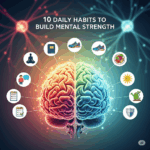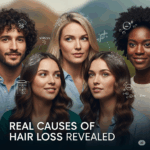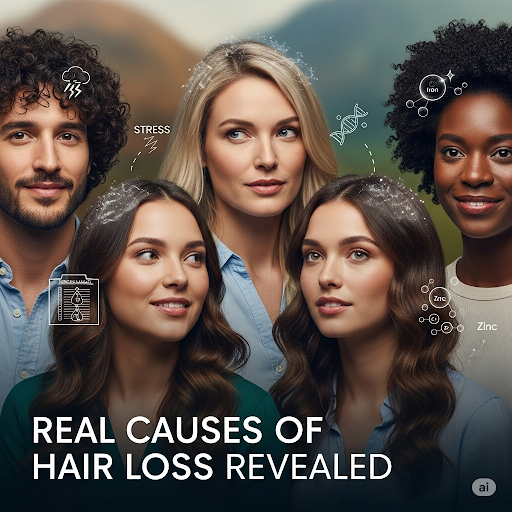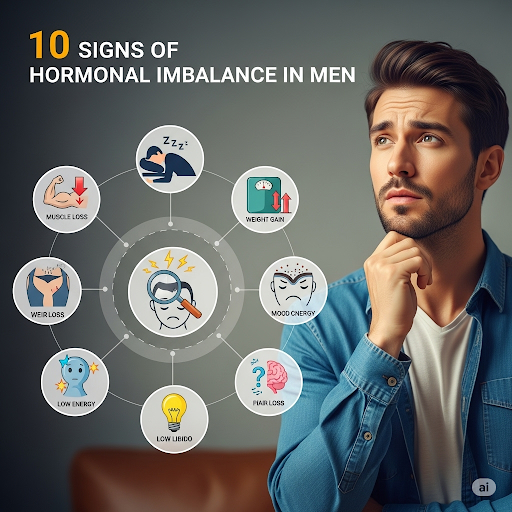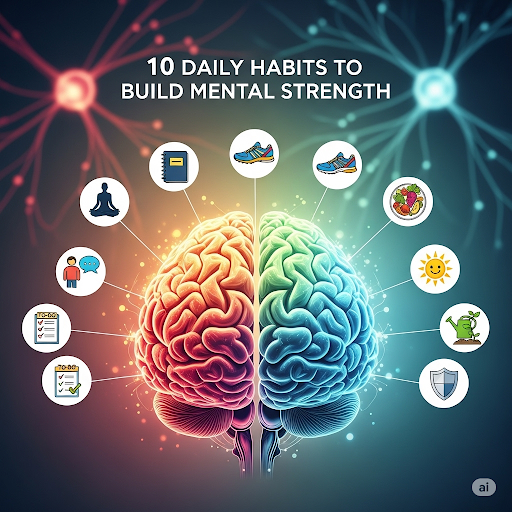The Truth Your Scalp’s Been Trying to Tell You
Introduction: It’s Not Just About the Hairbrush
We’ve all had that little panic moment in front of the mirror brushing our hair only to find clumps clinging to the bristles, or noticing that our once-full ponytail feels suspiciously thinner. You start wondering: Is it stress? Is it hormones? Is it something I ate? Or didn’t eat? Hair loss is one of those issues that feels incredibly personal, but you’re far from alone.
The truth is, hair loss doesn’t just happen out of the blue. Your body is always sending signals whispers that something deeper might be going on. And no, it’s not always genetics. Let’s walk through the real, often overlooked causes of hair loss and how they might be showing up in your daily life.
1. Hormonal Havoc: When Your Inner Chemistry Turns Against Your Hair
If you’ve ever felt like your hair has a mind of its own during certain times of the month or during pregnancy, postpartum, or menopause it’s because it does. Hormones are like the body’s internal orchestra. When they’re in sync, everything flows beautifully. But when they’re out of tune, one of the first places you’ll notice it is your scalp.
Estrogen and progesterone support hair growth, while excess androgens (like testosterone) can shrink hair follicles, leading to thinning and loss. This is especially common in conditions like PCOS or during menopause when estrogen dips and testosterone takes the lead.
Postpartum hair loss? It’s the sudden drop in pregnancy hormones. It’s normal but brutal. The good news? In many cases, it’s temporary. But if it feels extreme or doesn’t stop, it’s worth getting your hormones checked.
2. Chronic Stress: The Silent Strangler of Your Strands
Have you ever had a phase in life where everything was overwhelming work, family, health and suddenly, your hair started falling out in what felt like buckets? That’s not your imagination. That’s telogen effluvium, a fancy name for stress-induced hair loss.
When your body is under stress, whether physical (surgery, illness) or emotional (anxiety, trauma), it shifts its priorities. Hair growth isn’t vital for survival, so your body says, “Let’s take a break here,” pushing more follicles into the shedding phase.
The frustrating part? You often don’t notice the fallout until 2–3 months after the stress has occurred, which makes it hard to connect the dots. But once you manage the stress through rest, support, therapy, or lifestyle changes your hair often comes back stronger.
3. Nutritional Deficiencies: What Your Hair’s Craving
Hair is a luxury tissue. That means your body only gives it love when everything else is taken care of. If you’re missing key nutrients, your hair is one of the first places to suffer.
Some of the most common culprits behind nutritional hair loss?
- Iron deficiency: Particularly common in women, especially if you have heavy periods or don’t eat red meat.
- Vitamin D: Essential for follicle health and new growth.
- B vitamins, especially biotin, B12, and B6: Critical for strong, healthy strands.
- Zinc and magnesium: Both help regulate growth and repair.
Crash diets, restrictive eating, or gut absorption issues (like IBS or celiac) can rob your hair of these building blocks. So, if you’ve been skipping meals, following a fad diet, or living off caffeine and toast your hair may be quietly protesting.
4. Thyroid Troubles: That Little Butterfly Gland Can Make Your Hair Fly Away
The thyroid is a tiny gland with massive power. It regulates your metabolism, energy levels, and you guessed it your hair cycle.
When your thyroid is underactive (hypothyroidism), hair becomes dry, brittle, and starts thinning especially on the eyebrows and scalp. If it’s overactive (hyperthyroidism), you may see rapid hair shedding all over your head.
And here’s the kicker: thyroid issues often go undiagnosed for years because the symptoms can be so vague fatigue, mood swings, weight changes. If your hair loss is accompanied by any of these, ask your doctor to run a full thyroid panel (not just TSH).
5. Scalp Health: Your Hair’s Real Soil
Hair doesn’t just grow from your scalp it grows through it. And just like a plant needs healthy soil, your hair needs a healthy scalp.
Dandruff, inflammation, seborrheic dermatitis, psoriasis, and even excess product buildup can clog follicles and block healthy hair from growing. If your scalp is itchy, flaky, or greasy more often than not, you may be dealing with a problem right at the root literally.
A simple fix? Gentle exfoliation, switching to clean or medicated shampoos, and sometimes anti-fungal treatments. Think of it as skincare for your scalp it’s not just about shampoo anymore.
6. Autoimmune Disorders: When Your Body Mistakes Your Hair for the Enemy
In autoimmune conditions like alopecia areata, lupus, or Hashimoto’s thyroiditis, your immune system goes rogue and starts attacking your own hair follicles. This can cause sudden bald patches, overall thinning, or scarring.
It’s often unpredictable and emotionally challenging but there are treatments that can help reduce inflammation and encourage regrowth. Steroid injections, immunotherapy, or lifestyle changes aimed at calming the immune system can all play a role.
If your hair loss feels extreme or shows up in patches, don’t ignore it it’s your body waving a red flag for help.
7. Genetics: The Inherited Hair Lottery
Yes, genetics matter but they’re not the whole story. If your mom, dad, or grandparents had thinning hair, chances are, you might too. This type of hair loss is called androgenetic alopecia and affects both men and women.
For women, it often starts with widening of the part or overall volume loss not bald spots. It’s gradual and influenced by age, hormones, and yes, family history.
But even with genetics at play, you’re not powerless. Treatments like minoxidil, low-level laser therapy, or DHT blockers can slow down the process and help preserve what you’ve got.
8. Medications and Medical Treatments: The Unseen Side Effects
Certain medications list hair loss as a side effect and sometimes, it catches people completely off guard. Common culprits include:
- Blood pressure medications
- Antidepressants
- Birth control pills
- Chemotherapy (of course, in extreme cases)
- Acne or cholesterol medications
If your hair loss began after starting a new prescription, talk to your doctor. There may be alternative options or you may be able to support your hair health with supplements and scalp care during treatment.
9. Hairstyling Habits: Beauty That Hurts
We all love sleek buns, tight braids, flat irons, and colorful dyes but your hair doesn’t always agree. Constant pulling, heat, or chemical exposure can weaken the hair shaft and even damage follicles over time.
This type of hair loss, known as traction alopecia, is especially common in people who regularly wear tight hairstyles or use relaxers. And the sad part? If it continues too long, the damage can be permanent.
Your hair wants to breathe, move, and live. So be kind to it. Go heat-free more often, wear looser styles, and don’t underestimate the power of a deep conditioning treatment.
10. Aging Gracefully and Hairfully
Let’s be real some hair loss is part of the aging process. As we get older, our hair naturally thins. Growth slows down. Strands become finer. But this doesn’t mean you have to give up on vibrant, healthy hair.
What matters is how you support your body through those changes eating well, reducing stress, being gentle with your scalp, and supplementing where needed. It’s not about chasing 25-year-old hair in your 50s it’s about helping your hair be the healthiest version of itself at every age.
Final Thoughts: Listen to the Message, Not Just the Mirror
Hair loss is more than just a cosmetic concern it’s often a message from your body that something needs attention. Whether it’s stress, hormones, nutrition, or medical conditions, your hair is a reflection of your inner health.
The key is not to panic but to get curious. Dig deeper. Ask questions. Nourish your body, nurture your scalp, and know that regrowth is possible in many cases. Sometimes, all it takes is listening.
Your hair’s story is your body’s story. And every strand has something to say.

